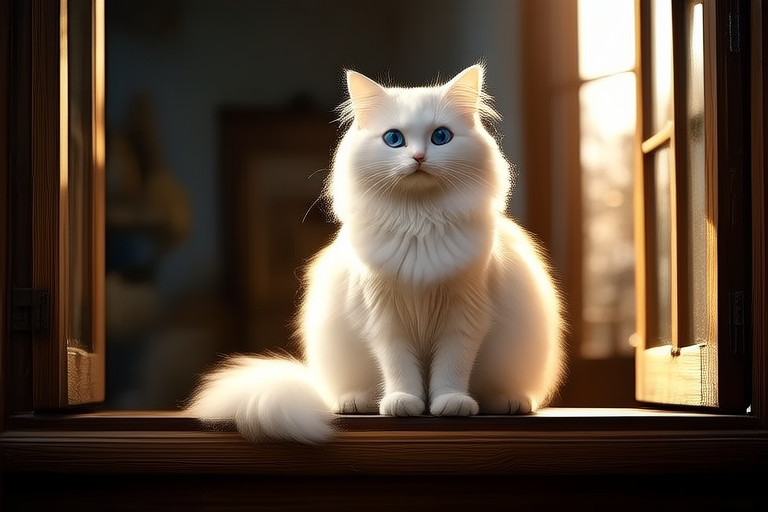Unveiling the Mystique: Life with a Ragdoll Cat
Welcome to the enchanting world of Ragdoll cats! These gentle giants of the feline kingdom have captured the hearts of many pet lovers with their striking appearance and affectionate nature. Known for their plush, semi-longhair coats and distinctive blue almond-shaped eyes, Ragdolls are more than just pretty faces. They are a breed that thrives on companionship and interaction, making them ideal for those seeking a loving and loyal companion. This article delves into the unique qualities of Ragdoll cats, offering insights into their characteristics, care requirements, training tips, and common health issues. Additionally, we will explore personal experiences and anecdotes from owners who have embraced life with these captivating creatures.
Ragdoll Characteristics
The first thing that strikes you about Ragdoll cats is their striking appearance. With their soft, silky coats and deep blue eyes, they look like living works of art. But it’s their temperament that truly sets them apart. Ragdolls are known for their docile and affectionate nature, often described as “dog-like” due to their tendency to follow their owners around and enjoy being carried. Their name comes from their tendency to go limp when picked up, reminiscent of a rag doll. This characteristic, combined with their playful yet calm demeanor, makes them perfect for families and individuals alike.
Temperament
Ragdolls are not only beautiful but also incredibly intelligent and social. They thrive on human interaction and love to be involved in everything their owners do. Whether it’s lounging on the couch, sitting by the window, or playing fetch, Ragdolls are always ready to join in the fun. Their adaptability makes them suitable for various living environments, from small apartments to large homes. Despite their laid-back nature, Ragdolls can be quite active and enjoy interactive toys and playtime. They are also known for their patience and tolerance, which makes them great companions for children and other pets.
Care Requirements
Proper care is essential to ensure your Ragdoll cat remains healthy and happy. Regular grooming is necessary to keep their luxurious coat free from tangles and mats. Daily brushing helps prevent hairballs and keeps their skin healthy. Additionally, maintaining a clean litter box and providing fresh water are crucial for their well-being. A balanced diet rich in protein, vitamins, and minerals is vital for their growth and maintenance. Consult with your veterinarian to determine the best food options for your Ragdoll based on their age, weight, and activity level. Regular veterinary check-ups and vaccinations are also important to prevent and manage potential health issues.
Training Tips
Ragdolls are highly trainable and respond well to positive reinforcement techniques. They can be taught simple commands such as “come,” “sit,” and “stay.” Training sessions should be short and fun, incorporating treats and praise to encourage good behavior. Clicker training is particularly effective for Ragdolls, as it provides immediate feedback and rewards for desired actions. Consistency is key in training, so make sure to practice regularly and reward your cat for following commands. With patience and persistence, you can build a strong bond with your Ragdoll through training, making interactions even more enjoyable.
Common Health Issues
Like all breeds, Ragdolls are prone to certain health issues. Hypertrophic cardiomyopathy (HCM) is a genetic heart disease that can affect Ragdolls. Regular vet visits and early detection are crucial in managing this condition. Polycystic kidney disease (PKD) is another hereditary issue that can lead to kidney failure. Responsible breeding practices and genetic testing can help reduce the incidence of these conditions. Other common concerns include dental problems, obesity, and urinary tract infections. Maintaining a healthy lifestyle, including regular exercise and a balanced diet, can help prevent many of these issues. Always consult with your veterinarian if you notice any changes in your Ragdoll’s behavior or health.
Personal Experiences and Anecdotes
Many owners have shared heartwarming stories about their experiences with Ragdoll cats. One owner, Sarah, describes her Ragdoll, Luna, as her constant companion. “Luna follows me everywhere, whether I’m working at my desk or relaxing on the couch. She has a way of knowing when I need some company and always finds a way to be close to me. Her presence brings so much joy and comfort to my life.” Another owner, Mike, shares how his Ragdoll, Max, has become a beloved family member. “Max loves playing fetch and will bring his favorite toy to me whenever he wants to play. He’s also great with our kids and enjoys being part of family activities.”
Creating a Nurturing Environment
To create a nurturing environment for your Ragdoll, it’s important to provide plenty of opportunities for play and exploration. Interactive toys, scratching posts, and climbing structures can help stimulate their minds and bodies. Ragdolls also appreciate having a cozy space where they can retreat and feel safe. Soft bedding, blankets, and comfortable perches are excellent additions to their living area. Ensuring your home is secure and free from hazards is essential, especially for curious cats. By providing a stimulating and safe environment, you can help your Ragdoll thrive and enjoy a fulfilling life.
In conclusion, Ragdoll cats offer a unique and rewarding experience for those lucky enough to share their lives with them. Their beauty, intelligence, and affection make them cherished companions. By understanding their needs and providing proper care, you can ensure a long and happy relationship with your Ragdoll. Whether you’re a seasoned cat owner or considering adding a Ragdoll to your family, these gentle giants are sure to captivate your heart and bring endless joy into your home.
